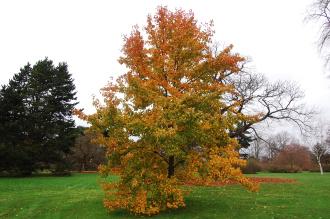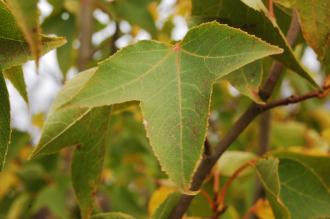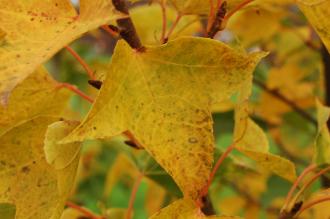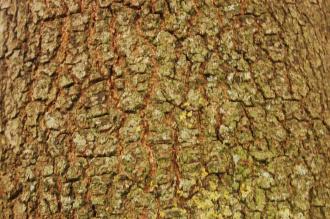
Liquidambar formosana Autumn (07/12/2015, Kew Gardens, London)
Position: Full sun to light shade
Flowering period: Spring
Soil: Moist but well drained
Eventual Height: 25m
Eventual Spread: 20m
Hardiness: 7a, 7b, 8a, 8b, 9a, 9b
Family: Altingiaceae

Liquidambar formosana Leaf (07/12/2015, Kew Gardens, London)
Liquidambar formosana is a deciduous tree with a rounded habit. Its mid green leaves are palmate with three lobes and serrate margins, up to 15cm long and 15cm broad. Its leaves turn red/ orange/ yellow in autumn before they fall. Its trunk may achieve a diameter of up to 1m. Its gray bark is corky in texture. Its green flowers are monoecious, being held separately on male and female branches. The fruit is spiky, globose, initially green maturing to brown and up to 5cm long. The roots of this tree are shallow rooting.

Liquidambar formosana Autumn Leaf (07/12/2015, Kew Gardens, London)
Liquidambar formosana, commonly known as Chinese Sweetgum or Formosan Sweetgum, is Native to the East Asia including central and south China, Taiwan and Indochina. In its native habitat it grows moist mixed woodlands.
The etymological root of the binomial name Liquidambar was given to it by Hernandez in reference to its aromatic gum, which he described as ‘liquid amber’. Formosana is derived from the former name of Taiwan, Formosa.
The landscape architect may find Liquidambar formosana useful as a specimen tree with attractive autumn color. It should be noted, due to the shallow rooting nature of this tree it may lift paving or cause maintenance issues in areas of grass.

Liquidambar formosana Bark (07/12/2015, Kew Gardens, London)
Ecologically, Liquidambar formosana flowers are attractive to pollinating insects, including bees.
Liquidambar formosana prefers moist, deep, fertile, well-drained soils. It prefers a neutral to acid pH of soil.
Liquidambar formosana requires little maintenance. Necessary pruning should be carried out in late autumn or winter.

Landscape Architecture

